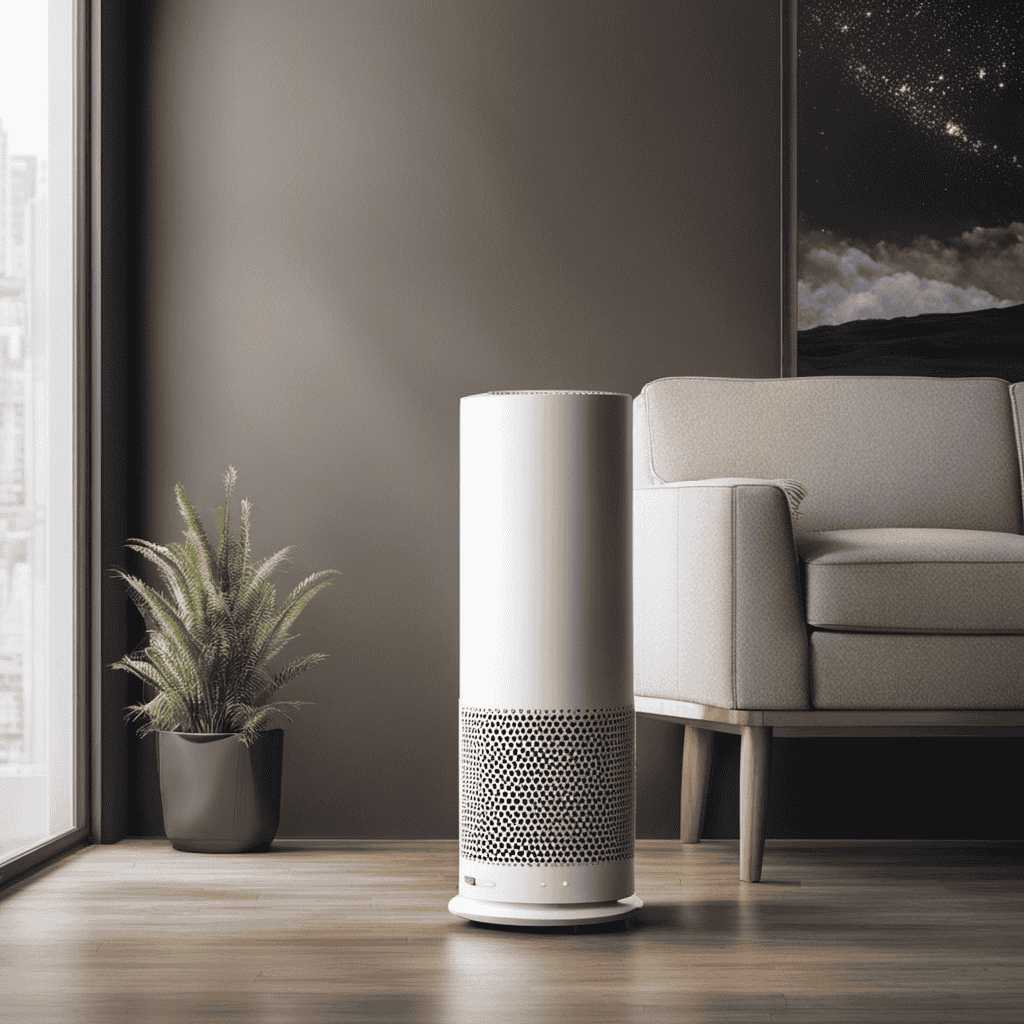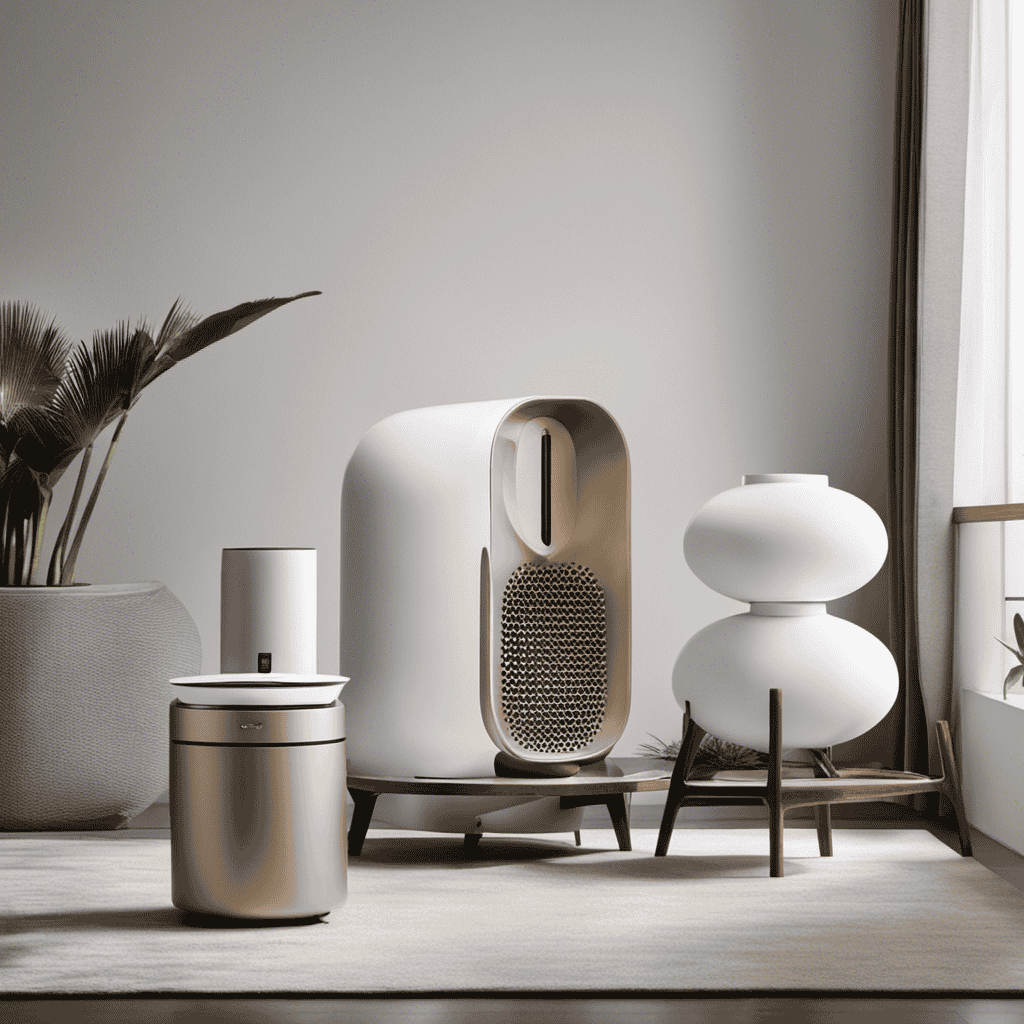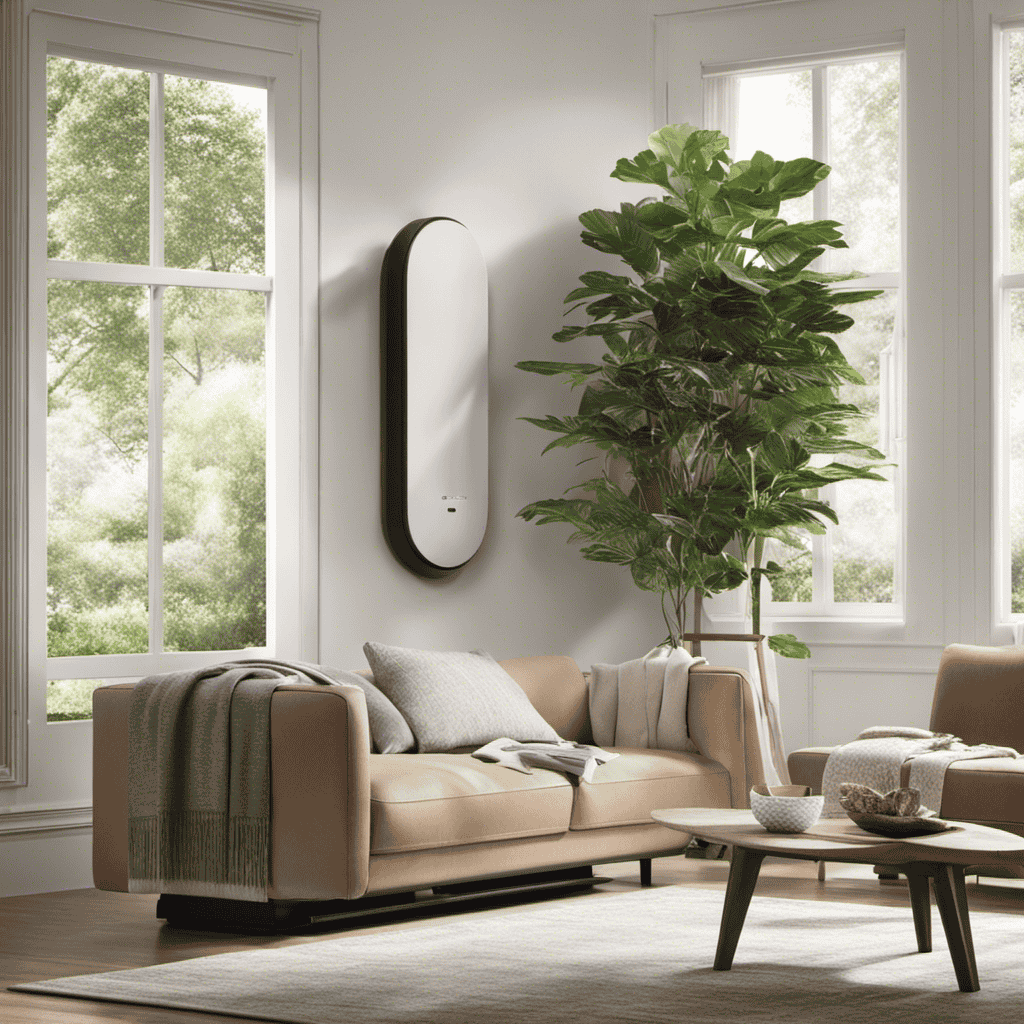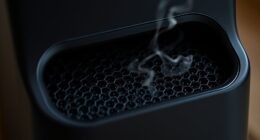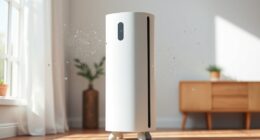The marvels of modern technology are truly remarkable! Have you ever stopped to think about the mysterious appearance of that white powdery substance that seems to be near your reliable air purifier? Do not worry, because I am here to explain this puzzling phenomenon.
In this enlightening article, we shall delve into the scientific intricacies behind the formation of white dust, explore the factors that contribute to its existence, and unveil the fascinating relationship between humidity and this seemingly innocuous substance.
Prepare to be astounded as we unravel the secrets of air purifiers and offer practical tips to minimize the accumulation of this enigmatic residue.
Key Takeaways
- White dust forms when certain types of humidifiers or air purifiers release vaporized water into the air.
- Tap water contains minerals like calcium and magnesium, which can become airborne particles and settle as white dust.
- Prolonged exposure to high levels of mineral dust can have potential health effects, especially for those with respiratory conditions.
- Understanding factors such as water quality, device used, and filter maintenance can help minimize white dust formation near air purifiers.
The Science Behind White Dust Formation
If you’re wondering why there’s white dust near your air purifier, it’s because of the science behind white dust formation.
The presence of white dust is a common issue that occurs when using certain types of humidifiers or air purifiers. The process begins with the water quality. Tap water contains minerals such as calcium and magnesium.
When the water is vaporized and released into the air by the device, these minerals can become airborne particles and settle as white dust. While white dust itself is not harmful, it can be a nuisance and affect the cleanliness of your surroundings.
However, it is important to note that prolonged exposure to high levels of mineral dust can have potential health effects, particularly for individuals with respiratory conditions.
Factors Contributing to White Dust Near Air Purifiers
As an expert in air purification systems, I have observed several factors that contribute to the formation of white dust near air purifiers.
One of the main factors is the mineral content in the water used in the humidification process. When this water evaporates, it leaves behind mineral deposits that can settle as white dust.
Another factor is improper filter maintenance, which can lead to the release of particles into the air.
Lastly, high air humidity can also contribute to the formation of white dust as it increases the chances of water vapor condensing and leaving behind mineral residues.
Mineral Content in Water
You may notice white dust near your air purifier due to the mineral content in your water. When water is used in air purifiers, it goes through a filtration process to remove impurities. However, some minerals can still remain in the water, and when it evaporates during the purifying process, these minerals can be released into the air as white dust particles.
This white dust is harmless and mainly consists of calcium, magnesium, and other minerals commonly found in water. While it may be unsightly, it does not pose any significant health risks. If you are concerned about the presence of white dust, you can use distilled or demineralized water in your air purifier instead. These types of water have been processed to remove minerals and can help prevent the formation of white dust.
Improper Filter Maintenance
Improper filter maintenance can lead to decreased efficiency in an air purifier. Regular filter replacement is crucial to ensure optimal performance and clean air circulation. Here are some consequences of neglecting filter maintenance:
-
Clogged filter: Dust, pollen, and other airborne particles accumulate on the filter, obstructing airflow and reducing the purifier’s ability to capture pollutants effectively.
-
Decreased air quality: A dirty filter cannot effectively trap contaminants, causing them to recirculate in the room, leading to poor air quality and potential health issues.
-
Increased energy consumption: When the filter is clogged, the air purifier needs to work harder, consuming more energy and increasing electricity bills.
-
Shortened lifespan: Without proper maintenance, the filter can deteriorate quickly, leading to frequent filter replacements and additional costs.
To maintain the efficiency of your air purifier, it’s essential to follow the manufacturer’s recommendations for filter replacement and cleaning.
High Air Humidity
Maintaining proper humidity levels is important for optimal air quality and overall comfort in your home. When it comes to air purifier benefits and technology, understanding the relationship between humidity and white dust is crucial.
High air humidity can contribute to the formation of white dust near your air purifier. This is because high humidity levels can cause the minerals in the water to become airborne and settle as dust particles. These dust particles can accumulate on surfaces, including near your air purifier.
To prevent the formation of white dust, it is recommended to use an air purifier with a built-in humidifier or to maintain proper humidity levels in your home using a separate humidifier. By controlling humidity, you can ensure a cleaner and healthier environment for you and your family.
Understanding the Relationship Between Humidity and White Dust
If you notice white dust near your air purifier, it could be due to high humidity levels in your home. Humidity has a significant impact on the formation of this white dust, which is actually mineral residue from your tap water.
When the air in your home is too humid, the excess moisture can cause the water in your air purifier to evaporate and leave behind mineral deposits. To prevent the formation of white dust, it is important to control the humidity levels in your home.
Here are some effective techniques:
- Use a dehumidifier to remove excess moisture from the air.
- Ensure proper ventilation in your home to allow moisture to escape.
- Consider using distilled or demineralized water in your air purifier to minimize mineral buildup.
- Regularly clean and maintain your air purifier to prevent the accumulation of white dust.
How Air Purifiers Can Produce White Dust
Air purifiers may contribute to the production of white residue due to the excess moisture in the air. This phenomenon occurs when the air purifier uses a method called ‘ionization’ to clean the air.
Ionization involves releasing negative ions into the air, which attach themselves to airborne particles such as dust, pollen, and pet dander. These particles then settle on surfaces and can create a white residue.
It’s important to note that not all types of air purifiers produce white residue. HEPA (High-Efficiency Particulate Air) filters, for example, do not use ionization and therefore do not contribute to the production of white dust.
Understanding the various types of air purifiers and their benefits can help in choosing the right one that suits your needs while minimizing the occurrence of white residue.
Tips for Reducing White Dust Accumulation
As an expert in air purification, I am well-versed in the causes of white dust and how to prevent its accumulation.
White dust is typically caused by the minerals present in hard water that is used in humidifiers or from the minerals in tap water used to clean the air purifier’s filter.
To prevent white dust, it is crucial to use distilled or demineralized water in humidifiers and to regularly clean and replace the air purifier’s filter.
Cleaning the air purifier itself is also essential to maintain its efficiency and prevent the spread of white dust particles into the air.
Causes of White Dust
One possible sentence could be: ‘The main cause of white dust near air purifiers is the use of ultrasonic humidifiers.’ This occurs due to the process of atomizing water into fine particles, which can then settle as dust.
The white dust is formed when minerals and impurities present in the water are released into the air. The water quality plays a significant role in the amount of dust produced, as higher mineral content leads to more residue.
Breathing in this dust can have adverse health effects, such as respiratory irritation and allergies. To prevent white dust accumulation, it is important to address the root cause by using distilled or demineralized water in the humidifier.
Additionally, regular maintenance and cleaning of the air purifier and humidifier can help minimize dust production.
Preventing White Dust
In order to prevent white dust near your air purifier and minimize mineral buildup, there are several steps you can take. First, it’s important to choose an air purifier with a built-in humidifier. This will help to add moisture to the air, reducing the likelihood of mineral particles becoming airborne. Additionally, regularly cleaning and maintaining your air purifier is crucial. This includes cleaning or replacing the filters as recommended by the manufacturer. It’s also a good idea to use distilled water in the humidifier, as it contains fewer minerals than tap water. Lastly, consider using a demineralization cartridge or an anti-mineral pad in your humidifier. These accessories are specifically designed to capture and trap mineral particles, preventing them from being released into the air.
| Preventing White Dust |
|---|
| 1. Choose an air purifier with a built-in humidifier. |
| 2. Clean and maintain your air purifier regularly. |
| 3. Use distilled water in the humidifier. |
| 4. Consider using a demineralization cartridge or anti-mineral pad. |
Cleaning Air Purifier
Regularly cleaning and maintaining your air purifier is crucial to ensure its optimal performance. Neglecting to clean your air purifier can result in decreased efficiency and the buildup of dust and debris, which can negatively impact the air quality in your home.
To effectively clean your air purifier, consider the following techniques:
-
Removing and cleaning the filters: This involves carefully removing the filters from the unit and gently washing them with warm water and mild soap. It is important to allow the filters to fully dry before reinserting them.
-
Vacuuming the exterior: Use a soft brush attachment to gently remove any dust or debris that may have accumulated on the exterior of the unit.
-
Wiping down the surfaces: Use a damp cloth to wipe down the surfaces of the air purifier, removing any dirt or grime that may have collected.
-
Checking the fan and motor: Regularly inspect the fan and motor for any signs of dust or debris buildup and gently clean if necessary.
Is White Dust Harmful to Health?
White dust from air purifiers can aggravate respiratory conditions. It is important to understand the impact of this white dust on indoor air quality and the health risks associated with indoor air pollutants.
When air purifiers are in use, they can generate white dust due to the process of filtration. This white dust consists of tiny particles such as minerals, dust mites, and other impurities that are captured by the purifier. While the presence of white dust may indicate that the air purifier is effectively removing pollutants from the air, it can also pose health risks.
Inhaling these particles can irritate the respiratory system, triggering allergies and worsening conditions such as asthma. Therefore, it is crucial to regularly clean and maintain air purifiers to minimize the release of white dust and ensure optimal indoor air quality.
Can an Air Purifier Cause White Dust to Appear?
Yes, an air purifier can cause white dust to appear, especially when using a humidifier. To avoid this issue, it’s essential to invest in the best air purifier for dirt, equipped with a high-quality filter that captures particles without releasing them back into the air.
Frequently Asked Questions
Can White Dust Near Air Purifiers Cause Damage to Furniture or Electronics?
Yes, white dust near air purifiers can cause allergies or respiratory issues due to the fine particles being released into the air. To clean white dust accumulations effectively, use a soft cloth or vacuum with a brush attachment.
How Often Should Air Purifier Filters Be Replaced to Prevent White Dust Formation?
I recommend replacing air purifier filters regularly to prevent white dust buildup. It’s important to clean them properly and frequently to maximize the benefits of using air purifiers and maintain their effectiveness.
Are There Any Specific Types of Air Purifiers That Are More Prone to Producing White Dust?
Yes, certain types of air purifiers, such as those with ultrasonic humidifiers or evaporative filters, can be more prone to producing white dust. It is important to read air purifier reviews and understand the benefits of using an air purifier.
Can Using Distilled Water Instead of Tap Water in Air Purifiers Help Reduce White Dust Accumulation?
Using distilled water in air purifiers can reduce white dust accumulation. Tap water contains minerals that can be released as white dust particles. Distilled water lacks these minerals, resulting in cleaner air.
Is It Possible for Air Purifiers to Remove White Dust Particles From the Air?
Yes, air purifiers can effectively reduce white dust particles in the air, improving indoor air quality. The impact of white dust on air quality is significant, making it important to use an air purifier to remove allergens.
Conclusion
In conclusion, understanding the reasons behind the formation of white dust near air purifiers is crucial for maintaining a healthy indoor environment.
While high humidity levels and certain types of air purifiers can contribute to its production, it is important to note that white dust is not harmful to health.
However, it can be a nuisance and affect the overall cleanliness of your home.
Interestingly, a study found that using a humidifier with demineralization cartridges can reduce white dust accumulation by up to 94%.
